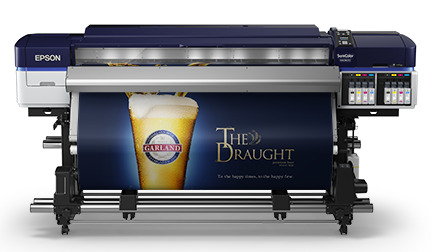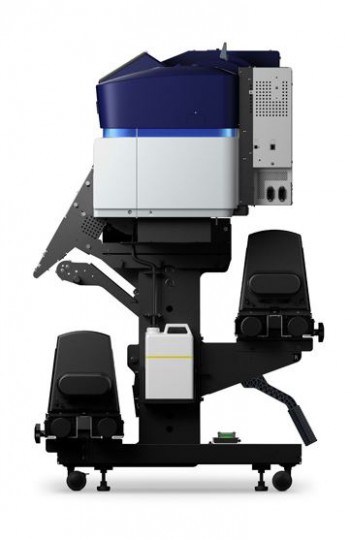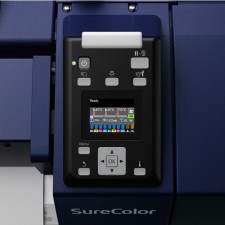
By Michael Clementi
As I’m writing this review, my mind continues to be blown just thinking about what I’ve witnessed: An eco-solvent printer that can harness incredible speed (up to 550 square-feet per hour) and quality while using only a dual CMYK ink set. Further than that, I’ve never seen a printer that can print two-pass or four-pass modes without a single ounce of banding throughout a full-color graphic … until now.
So now that I’ve wet your whistle a bit on some of the juicy details, I can underline for you what the fine people at Epson have done to bring a new revolutionary printer to the outdoor printing industry, namely the SureColor S60600.
Let’s start out with what they brought back from the previous S-series printers … next to nothing. This is literally a ground up rebuild from the take-up reel and stand to the new filtration unit on the top of the printer, and everything in between. For the sake of organized reading we will start at the ground level with the stand.
The integrity of the print can rely heavily on how sturdy the printer is while it is actually laying down multiple droplet sizes of ink and using very complex screening algorithms. That’s nerd talk for explaining how stability affects print quality.
Much like a car chassis, stability comes in solid metal and reinforcement, which is exactly what Epson has done with their base and take-up unit. In fact, it’s like a repeated mantra throughout: “Where there was plastic, let there be metal.” The S60600 is an extra 100 pounds more industrial than its predecessor.
 Extremely accurate unattended printing is a major upgrade with the new S60600. The take-up reel has completely been restructured, too. I can attest that this is the best take-up system in the industry right now as far as keeping the material straight as it is being taken up. Not to mention loading it is a breeze. You can even load it on the fly as it is printing so you do not have to waste the initial 6 feet of material to reach the take-up.
Extremely accurate unattended printing is a major upgrade with the new S60600. The take-up reel has completely been restructured, too. I can attest that this is the best take-up system in the industry right now as far as keeping the material straight as it is being taken up. Not to mention loading it is a breeze. You can even load it on the fly as it is printing so you do not have to waste the initial 6 feet of material to reach the take-up.
There is an entirely new internal pinch roller system (the wheels on top of the media that hold it down to the platen). The new system has even pressure all the way across the material, which is a major improvement from the prior generation.
We have had our unit in-house for almost a month now, and we have run everything from canvas, fabrics, photo papers, vinyl, adhesive vinyl and backlit, to name a few, and have not had to throw a single print away due to head strike. There are also now three stages of pressure that are adjustable for how much pressure the pinch rollers are applying to the material. This prevents any chance of impressions or roller marks.
With the new Precision Core TFP print heads in their latest release partnered with an all new GS3 ink formulation, wiper unit and air filtration system, Epson has significantly decreased the amount of user maintenance that is required. In fact, after almost a month of printing and running about 15 full rolls, 100 plus feet each of an array of fibrous products on top of another 10 rolls or so of banner and adhesive vinyl, we have produced a 100% yield.
In past versions of its solvent printers, Epson has recommended a once-a-week manual maintenance. Now that has been pushed back to a once-a-month manual maintenance with its new printers. This is an amazing accomplishment, and I believe that the brand new air filtration system has a lot to do with it.
 Inside the printer there is a quiet vacuum system that moves the air through two filters (user replaceable) at the top of the machine. This filtration system removes dust and ink particles from interfering with the nozzles. I can visually see a difference when looking at the print head that this new system is doing its job. Normally after running 15 rolls of fibrous materials, like canvas, on past Epson models, you would see some particles of cotton fibers or dust visible on the actual print head. When closely examining the new heads, I noticed that the inks residing on the print heads were very clean and particle-free.
Inside the printer there is a quiet vacuum system that moves the air through two filters (user replaceable) at the top of the machine. This filtration system removes dust and ink particles from interfering with the nozzles. I can visually see a difference when looking at the print head that this new system is doing its job. Normally after running 15 rolls of fibrous materials, like canvas, on past Epson models, you would see some particles of cotton fibers or dust visible on the actual print head. When closely examining the new heads, I noticed that the inks residing on the print heads were very clean and particle-free.
With regards to print quality, Precision Core means exactly that. At the core of rebuilding its solvent printers, Epson has focused on precision imaging, and that surely shows on the final output. Epson incorporates the same print head technology that it’s using in the photographic Epson P-Series printers. The output, even at the fastest pass modes, goes way beyond a sellable print and boasts the S60600 as the fastest of the solvent/eco-solvent printers on the market.
These reviews are for educational purposes. I write this from an unbiased user standpoint, and I do not get paid to do so by anyone. Although I just realized there was not a single mention of anything negative. The fact is that I couldn’t find anything negative to write about.
Feel free to post any questions or comments and I will reply back! Thanks for reading.
